
| 
|

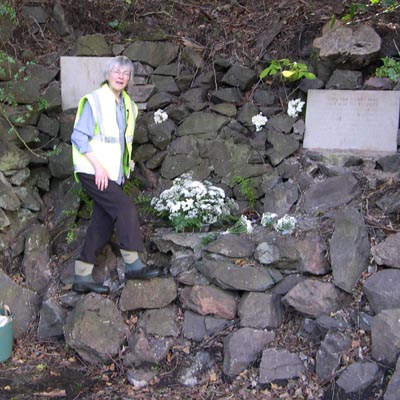
Ellerslie Fountain
NGR 77486 45007
Site Number: C90
By Bruce Osborne and Cora Weaver (C) 2012
Area 4. West Malvern Springs and Wells
Malvern Hills, England
Description: A paved recess set in a curved wall of Malvern stone
The idea for this fountain came from W.R Lloyd of Birmingham. In 1860 he was recuperating in Malvern and decided to set up a subscription fund to raise money for a new fountain where visitors like himself could rest and take a drink of spring water. The Malvern Advertiser on the 4th February 1860 carried details of a letter from Mr Lloyd to the Commissioners, giving a list of subscribers to the fountain to be errected on the Wells Road, near Ellerslie. The fountain was named after Ellerslie House, a large, private house on Ellerslie Pitch that was once Dr Edward Johnson's hydropathic establishment where he treated Florence Nightingale in the 1850s. 'Ellerslie Pitch' - the steep south end of Abbey Road - was a term still in use as recently as the 1930s. Ellerslie House had its own source of natural water having a well and 'a private supply of the celebrated spring water from the Hills'.[1] This was probably from Darkes Tank. Workmen excavating the hillside had chanced upon an ancient watercourse, suggesting an earlier utilisatiion of the source. Analysis also indicated it to be different to the St Ann's Well supply.[2]
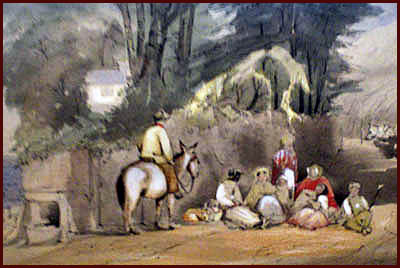
In August 1860 The Illustrated London News announced the opening of the new fountain. It eulogised that no amount of architectural effort could create such a style that, with the Malvern Hills as its backdrop, was in natural harmony with the scenery. Lady Emily Foley, on whose land the fountain was built, agreed to have a fence put round the fountain to stop animals intruding, and to plant trees round it for shade and seclusion. It may also have been she who later provided the two incised stones that flanked the spout and basin. One beckons the passers-by:
Here the WEARY may
rest and the THIRSTY
refresh, and, as all on their
way are freely welcome to
partake of these blessings,
So are they invited to preserve
and protect from every injury
this FOUNTAIN ERECTED 1860
The text on the latter are Jesus's words to the Samaritan woman at Jacob's Well in Sychar, Samaria:
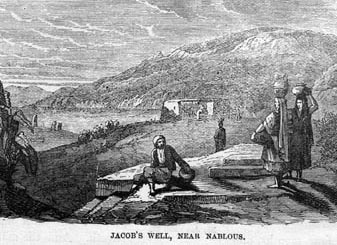
Jesus saith unto her
whosoever drinketh of this
fountain shall thirst again; but
whosoever drinketh of the water
which I shall give unto him shall
never thirst. St John 4 13-14.
A contempoary descrition was that it is a Malvern stone lined recess in the walled bank alongside the road; the recess is paved and iron railings surround the perimeter of the area. Unfortunately those that did drink here did thirst again because the water supply quickly proved unreliable. By 1864 the flow was reduced to a trickle, possibly as a result of the water source being redirected.[3]
Further mention of the fountain occurs in August 1879 when it was suggested that the Wells Road should be widened between the Ellerslie Fountain and the milestone because four or five roads intersected each other at that point,[4] close to the site of the toll house and Lower Turnpike Spring see site 90. The milestone still exists on the opposite roadside a short distance south of the fountain. In August 1879 it was recorded that the fountain was enclosed by fencing and carried an incised, painted inscription.[5]
In 1867 water Cure pioneer Dr James Wilson died, and in 1872 the wealthy and charismatic Dr James Gully left Malvern. The water cure visitors, who had once flocked in hordes, stayed away, and the town began to sink to its knees. Lodging house keepers went out of business and the water features decayed. In August 1879 an anonymous lady volunteered to maintain Ellerslie fountain and to reincise and paint the inscription. Also in 1879, a Mr Atkins applied to put in a 4 inch pipe, 2 ft deep, to take the waste water from Darkes Tank and the Ellerslie Fountain.[6] This was possibly to divert the water to his property.
The report of an excursion to Malvern in July 1883 suggests that the fountain was prone to seasonal fluctuations.
A party of 400 workers from a large manufacturing town had come to Malvern for their annual outing. Like all excursionists they alighted from the train at Malvern Link Station and walked in groups along the road to Little Malvern, admiring the beautiful houses and scenery as they went. At Little Malvern they decided they couldn't manage the walk as far as the Herefordshire Beacon so they ascended the hill at Little Malvern and walked along the brow as far as the Wyche. A member of the party tells how they 'descended the Wych pass on our way to Malvern. Having walked some distance along this road and growing somewhat fagged and parched with the journey, we were attracted by what appeared to be a welcome spring of water by the roadside, bearing an inscribed tablet inviting the weary traveller to take rest and refreshment by the way; but upon a closer inspection were disappointed at finding 'the well run dry'. Whether this spring is a local `puzzle' for the traveller to find the water or whether the famous springs of Malvern are at all declining we did not stay to inquire.
Passing on nearer to the town we were again cheered by what appeared to us to be a handsome drinking fountain, but alas! we were once more doomed to disappointment. This very artistic structure, costing no doubt a larger sum of money, we were surprised to find erected in a comparatively obscure part of the town, and although built some years ago yet failing in its chief object of supplying water to the public, the grass even growing round its base, and altogether presenting a very neglected appearance.' A little later in the day: 'Having partaken of tea, we made our final feat of pedestrianism by climbing to the Worcestershire Beacon so far as the world-renowned St Anne's Well which we of course found a most pleasant spot, and were greatly edified at learning from the eloquent attendant at the well the many and varied maladies which this celebrated water is calculated to cure.'[7]
It is possible to retrace the route taken by this party of visitors. From The Wyche, they walked down the Old Wyche Road, passing Morris's Lower Wyche Spout, then followed Wells Road towards Great Malvern, encountering the dry Ellerslie Fountain on the left. Crossing the road they went down Abbey Road and found Wilson's Memorial Fountain was also without and in a sorry state. They then walked to town and eventually climbed up to St Ann's Well.
The idea of seasonal fluctuations is supported when early in 1895 a newspaper editorial commented that at the corner of the main road, 'near to what is called Ellerslie Pitch, is a spring tastefully surrounded by rock-work with ferns and mosses growing abundantly in the crevices. The water is bright and sparkling and excellent for drinking...' But that summer, public-spirited Miss C E Symonds of Laurel Villa wrote to the Council (Malvern Urban District Council replaced the Local Board at the end of 1895) complaining of the dilapidated state of Ellerslie Fountain, and her offer to remedy the situation was readily accepted.[8]
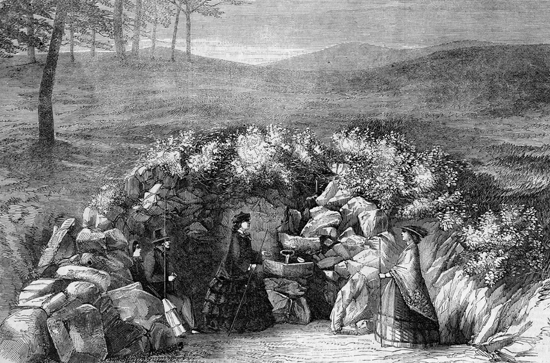
In 1899 Dr Charles Grindrod, a conscientious member of the Council, reported that the fountain was stopped up and suggested it should be connected to the mains.[9] He repeated the suggestion later that month and, the administrative wheels turning slowly, the Surveyor was instructed in June to connect the drinking fountain to the mains. Three years later the fountain was again out of order.[10] Nor was there any water there in 1903 in spite of Lady Foley's successor and Chairman of the Council Sir Henry Lambert giving instructions that the problem be put right at his expense.[11]
As a child in the 1930s Martin Stringfellow lived in Poolbrook. Today, in 2011, he still remembers how, when he and his young friends climbed the hills, they drank at the springs and wells as they went. He recalled that, at the outbreak of the Second World War, Ellerslie Fountain was still in good condition though it was the boys' own hands that made the cup. By the early 1990s Ellerslie Fountain was long-forgotten; the Malvern stone backcloth was partly obscured with wild undergrowth and overgrowth and the paved area thick in the rich, black compost of years of dead foliage. Surprisingly the stone tablets, resembling two lost gravestones, survived, though the inscriptions were almost illegible.
Today the fountain is dry, but surprisingly survives in its near original state. The remains of the iron spout can be seen in the back wall. In 2007, funded by a Heritage Lottery Fund grant, years of fallen leaves and rotted natural vegetation was cleared from an overgrown and forgotten Ellerslie Fountain and the two tablets were replaced, the originals being put in the care of Malvern Museum. There is also the remains of a nineteenth-century iron animal trough a couple of metres to the north but any fountain basin that once existed has long since disappeared. Sometimes a spring erupts behind Ellerslie from beneath the Wyche Road embankment. This flows down the bank about 10 yards north of Ellerslie.
Illustrations:
1. Once forgotten, the revived Ellerslie Fountain was decorated in 2008 showing the replacement plaques.
2. The original stone plaques now in the care of Malvern Museum.
3. What is thought to be the earliest known picture of the Ellerslie site before the development in 1860. Dated 1850, this painting is by Mary Brandling and depicts the corner where the fountain now resides. The blue mottled area to the left is the view south towards Malvern Wells and the building is likely what later became Southdown House on the Wyche Road.
[1] Malvern Advertiser, 8 April 1893.
[2] Malvern Guardian January 1895 p.14.
[3] Malvern Advertiser, 23 April 1864.
[4] Malvern Advertiser, 9 August 1879.
[5] Malvern Advertiser 23 Aug 1879.
[6] Malvern Advertiser 21 Feb 1880.
[7] Malvern Advertiser 14 July 1883.
[8] Malvern Advertiser 3 Aug 1895.
[9] Malvern Advertiser 11 Mar; 1 Apr; 10 June 1899.
[10] Malvern Advertiser 8 Mar 1902.
[11] Minutes Malvern Urban District Council 1 Sept 1903.
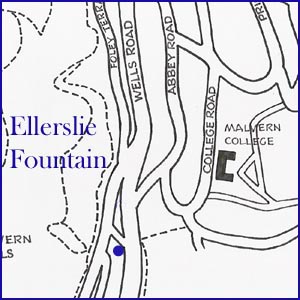
Website: Click Here
SUPPLEMENTARY INFORMATION

Celebrated Springs of
THE MALVERN HILLS
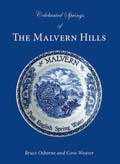 A definitive work that is the culmination of 20 years researching the springs and wells of the Malvern Hills, published by Phillimore. This is the ideal explorers guide enabling the reader to discover the location and often the astounding and long forgotten history of over 130 celebrated springs and wells sites around the Malvern Hills. The book is hard back with dust cover, large quarto size with lavish illustrations and extended text. Celebrated Springs contains about 200 illustrations and well researched text over a similar number of pages, together with seven area maps to guide the explorer to the locations around the Malvern Hills. It also includes details on the long history of bottling water in the Malvern Hills.
A definitive work that is the culmination of 20 years researching the springs and wells of the Malvern Hills, published by Phillimore. This is the ideal explorers guide enabling the reader to discover the location and often the astounding and long forgotten history of over 130 celebrated springs and wells sites around the Malvern Hills. The book is hard back with dust cover, large quarto size with lavish illustrations and extended text. Celebrated Springs contains about 200 illustrations and well researched text over a similar number of pages, together with seven area maps to guide the explorer to the locations around the Malvern Hills. It also includes details on the long history of bottling water in the Malvern Hills.
Written by Bruce Osborne and Cora Weaver, this book is available on-line for £15.00 (delivered UK) - click Malvern Bookshop on the green panel top left. Alternatively send a cheque payable to Cora Weaver with your name and address to 4 Hall Green, Malvern, Worcs. WR14 3QX.
1) TOPOGRAPHICAL LOCATION:
Malvern Hills - arguably Britain's original National Park
2) LANDSCAPE:
Built Up Location3) INFORMATION CATEGORY:
A Spring, Spout, Fountain or Holy Well Site4) MALVERN SPRING OR WELL SITE DETAILS:
4 SPLASHES - Well Worth Finding
5) GENERAL VISITOR INFORMATION:
Access By RoadAccess On Foot
Free Parking Nearby
Accessible All Year


